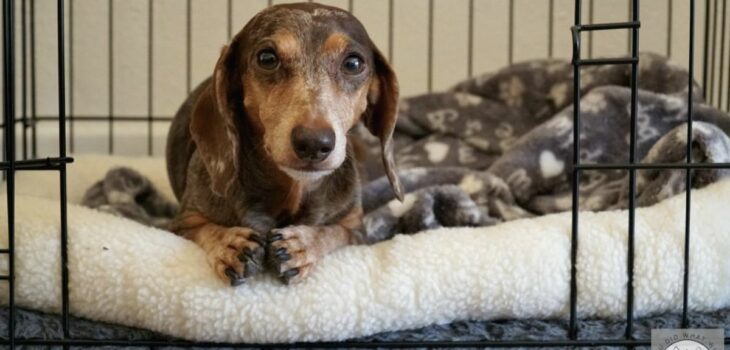A dog crate can be a very useful investment that benefits both you and your dog. When deciding on what size crate for dachshund you will need to consider the size of your dog and what you intend on using the crate for. Let’s find out everything you need to know about dachshund crate size and help you choose the perfect one for your precious pooch!
Why Do You Need A Dog Crate?
Many people are put off buying a dog crate as they feel that it is cruel to lock their dog inside a crate. However, when approached correctly, crate training can be a very positive and beneficial experience for your dog. The idea is for your dog to come to regard the crate as a safe place where he feels secure and unthreatened.
Crate training a new dog can be a lengthy process that requires time and patience. It is not simply a matter of shutting the dog in the crate; the aim is for the dog to choose to go into the crate by itself. Initially, this will be just for short periods, after which your dog will be rewarded.
The advantage of crate training a dog is that you then have a safe and secure place to put your dog when for some reason he is not able to roam freely around the house or yard. It could be that you need to keep your dog somewhere secure when you are away from the house, or perhaps the crate will be somewhere for your dog to sleep at night. A dog that is accustomed to being in a crate will also be easier to transport outside the home and can even accompany you on day trips out and family holidays.
There is another rather unfortunate reason why crate training a dachshund is a good idea. These little wiener dogs are prone to spinal problems, which require long periods of rest to heal and recover. If your dog is already used to being in a crate, then it will find this process much less stressful.

How To Choose The Right Size Crate For A Dachshund
Although you are probably buying your dog crate when your dachshund is still a puppy, you have to bear in mind that your little pooch is going to grow into a full-size dog! This means you need a crate that is large enough for an adult dog, as well as any other essential accessories that should fit inside the crate.
The ideal dachshund kennel or crate should be secure and comfortable for your dog. It should contain a bed that provides enough space for your dog to sleep. Food and water bowls should be spill-proof, preferably attached to the side of the cage.
As your dog may sometimes need to spend long periods of time inside the crate, is a good idea to provide some other form of environmental enrichment. This will normally include some dog toys, treats, and puzzles to keep your dog entertained while in the crate.
When choosing the best crate for dachshund, the size of your dog is a key factor. It will also depend on whether you intend to use the crate to confine your dog for periods of an hour or more, or just for short trips to the veterinary clinic. A good piece of advice is to buy the biggest crate that you can which will comfortably fit in your living accommodation.
When deciding what size crate for dachshund, it will depend on whether you have a miniature or standard dachshund. An adult miniature dachshund will need a crate that is around 24″ x 18″ x 21″, whereas a standard dachshund will need a larger 30″ x 19″ x 21″ crate.
Many dachshund owners choose to keep these dogs in pairs, as they form close bonds with each other. Two standard dachshunds will need a crate that is around 31″ x 21″ x 24″ in size. If you plan on using your dog crate to transport your dog, make sure it will fit easily into the back of your car.
How To Crate Train A Dachshund
The best time to start crate training a dog is when it is still a puppy. Place items that smell familiar to the dog inside the crate and encourage it to go inside using treats, toys or food. To start with, the door should be left open when the dog goes into the crate.
As the dog feels more comfortable with the crate and start to go inside more willingly, the door can be closed for short periods. When the door is first closed, give your dog a treat – this will teach it not to fear the sound of the door closing. Start by leaving the door closed for just a few minutes and gradually build this up into longer periods of time.
When your puppy feels relaxed and comfortable inside the crate, it is time to start leaving him alone for very short periods. Try not to make a fuss when you depart or return, as this can trigger separation anxiety in your puppy. Simply slip out of the door when he is otherwise occupied with a treat or toy and come back a few moments later.
Summary – What Size Crate For Dachshund
So, as we have learned, when deciding what size crate for dachshund there are many factors you need to take into consideration. The size of your dog when fully grown is a key factor, and it will also depend on whether you intend to use the crate to confine your dog for periods of an hour or more, or just for short trips to the veterinary clinic. The crate should be large enough for the dog to have a comfortable bed, food, and water bowls, and toys to keep it entertained.

We would love to hear your thoughts on how to choose the perfect dachshund dog crate! Are you a big fan of crate training and find it really helped your new dog settle into your home? Or maybe you’ve got some questions about how to get your new dachshund puppy accustomed to using the crate? Leave a comment below and we will get back to you!




